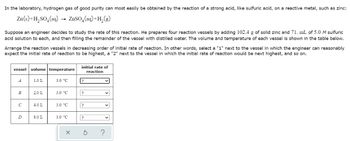
Chemistry
10th Edition
ISBN: 9781305957404
Author: Steven S. Zumdahl, Susan A. Zumdahl, Donald J. DeCoste
Publisher: Cengage Learning
expand_more
expand_more
format_list_bulleted
Concept explainers
Question
4

Transcribed Image Text:In the laboratory, hydrogen gas of good purity can most easily be obtained by the reaction of a strong acid, like sulfuric acid, on a reactive metal, such as zinc:
Zn(s) + H₂SO4 (aq) → ZnSO₂(aq)+H₂(g)
Suppose an engineer decides to study the rate of this reaction. He prepares four reaction vessels by adding 102.4 g of solid zinc and 71. mL of 5.0 M sulfuric
acid solution to each, and then filling the remainder of the vessel with distilled water. The volume and temperature of each vessel is shown in the table below.
Arrange the reaction vessels in decreasing order of initial rate of reaction. In other words, select a "1" next to the vessel in which the engineer can reasonably
expect the initial rate of reaction to be highest, a "2" next to the vessel in which the initial rate of reaction would be next highest, and so on.
vessel
A
B
с
D
volume temperature
1.0 L
2.0 L
4.0 L
8.0 L
3.0 °C
3.0 °C
3.0 °C
3.0 °C
X
initial rate of
reaction
?
?
?
?
v
Expert Solution
This question has been solved!
Explore an expertly crafted, step-by-step solution for a thorough understanding of key concepts.
This is a popular solution
Trending nowThis is a popular solution!
Step by stepSolved in 3 steps with 3 images

Knowledge Booster
Learn more about
Need a deep-dive on the concept behind this application? Look no further. Learn more about this topic, chemistry and related others by exploring similar questions and additional content below.Similar questions
- What is [Fe2*] if E = 1.64 V, [Zn²+] = 0.25 M, and [Fe3+] = 0.75 M at 25 °C for the below voltaic %3D %3D cell? 2 Fe3+ (aq) + Zn (s) → 2 Fe2* (aq) + Zn²+ (aq) 0.042 M 0.035 M 0.029 M 0.009 M 0.017 Marrow_forwardThe percent concentration of a solution is a ratio of the amounts of dissolved solute and solution, expressed as a percentage. The percent concentration of a solution can be written generally as % concentration = amount of solute x 100% amount of solution Depending on the situation, a percent concentration might be calculated for mass/mass, volume/volume, or mass/volume. tab os lock ntrol esc alt option Q A Z 5,566 2 W S AUG 2 F2 X H command 3 20 E F3 D $ 4 C 888 R Part A F4 70 Calculate the mass percent of a solution that is prepared by adding 54.8 g of NaOH to 461 g of H₂O. Express your answer numerically. ► View Available Hint(s) LIVE ΑΣΦΑ++ ο Submit Part B F [ΫΠ| ΑΣΦ Calculate the mass/volume percent of a NaCl solution in which 136 g of NaCl is dissolved in enough water to give a total volume of 1.44 L . Express your answer numerically. View Available Hint(s) % 5 V T G - 0 B MacBook Air F6 Y & - V 8⁰ 7 H #tv NA ? F7 ? U N %(m/m) %(m/v) 00* J FB M ( 9 K L F10 P command Review I Cons…arrow_forwardPart B A student placed 12.5 g of glucose (C¢H12O6) in a volumetric flask, added enough water to dissolve the glucose by swirling, then carefully added additional water until the 100. mL mark on the neck of the flask was reached. The flask was then shaken until the solution was uniform. Á 45.0 mL sample of this glucose solution was diluted to 0.500 L. How many grams of glucose are in 100. mL of the final solution? Express your answer to three significant figures and include the appropriate units. • View Available Hint(s) Value Units Submitarrow_forward
- 1. XY,(aq) + T(s) – – > TX(s) + Y(s)arrow_forwardIf a person has a blood glucose level of 106 mg / 100. mL, a level that can cause brain damage, what is the total mass (in grams) of glucose in 4.91 L of blood? g glucosearrow_forwardSubtract 3.58 * 10 ^ - 2 kg from 1.41 * 10 ^ 11 ng and report your answer in garrow_forward
- (3)arrow_forwardA student was able to separate the three components of a mixture via liquid chromatography. She obtained 1.27 g1.27 g of component A, 0.950 g0.950 g of component B, and 0.260 g0.260 g of component C. Determine the mass percent of each of the three components in the mixture.arrow_forwardWhat is the following and what are the organic molecules? H H H H H C C (3 lines) C C C C H H H H Harrow_forward
arrow_back_ios
SEE MORE QUESTIONS
arrow_forward_ios
Recommended textbooks for you
 ChemistryChemistryISBN:9781305957404Author:Steven S. Zumdahl, Susan A. Zumdahl, Donald J. DeCostePublisher:Cengage Learning
ChemistryChemistryISBN:9781305957404Author:Steven S. Zumdahl, Susan A. Zumdahl, Donald J. DeCostePublisher:Cengage Learning ChemistryChemistryISBN:9781259911156Author:Raymond Chang Dr., Jason Overby ProfessorPublisher:McGraw-Hill Education
ChemistryChemistryISBN:9781259911156Author:Raymond Chang Dr., Jason Overby ProfessorPublisher:McGraw-Hill Education Principles of Instrumental AnalysisChemistryISBN:9781305577213Author:Douglas A. Skoog, F. James Holler, Stanley R. CrouchPublisher:Cengage Learning
Principles of Instrumental AnalysisChemistryISBN:9781305577213Author:Douglas A. Skoog, F. James Holler, Stanley R. CrouchPublisher:Cengage Learning Organic ChemistryChemistryISBN:9780078021558Author:Janice Gorzynski Smith Dr.Publisher:McGraw-Hill Education
Organic ChemistryChemistryISBN:9780078021558Author:Janice Gorzynski Smith Dr.Publisher:McGraw-Hill Education Chemistry: Principles and ReactionsChemistryISBN:9781305079373Author:William L. Masterton, Cecile N. HurleyPublisher:Cengage Learning
Chemistry: Principles and ReactionsChemistryISBN:9781305079373Author:William L. Masterton, Cecile N. HurleyPublisher:Cengage Learning Elementary Principles of Chemical Processes, Bind...ChemistryISBN:9781118431221Author:Richard M. Felder, Ronald W. Rousseau, Lisa G. BullardPublisher:WILEY
Elementary Principles of Chemical Processes, Bind...ChemistryISBN:9781118431221Author:Richard M. Felder, Ronald W. Rousseau, Lisa G. BullardPublisher:WILEY

Chemistry
Chemistry
ISBN:9781305957404
Author:Steven S. Zumdahl, Susan A. Zumdahl, Donald J. DeCoste
Publisher:Cengage Learning

Chemistry
Chemistry
ISBN:9781259911156
Author:Raymond Chang Dr., Jason Overby Professor
Publisher:McGraw-Hill Education

Principles of Instrumental Analysis
Chemistry
ISBN:9781305577213
Author:Douglas A. Skoog, F. James Holler, Stanley R. Crouch
Publisher:Cengage Learning

Organic Chemistry
Chemistry
ISBN:9780078021558
Author:Janice Gorzynski Smith Dr.
Publisher:McGraw-Hill Education

Chemistry: Principles and Reactions
Chemistry
ISBN:9781305079373
Author:William L. Masterton, Cecile N. Hurley
Publisher:Cengage Learning

Elementary Principles of Chemical Processes, Bind...
Chemistry
ISBN:9781118431221
Author:Richard M. Felder, Ronald W. Rousseau, Lisa G. Bullard
Publisher:WILEY